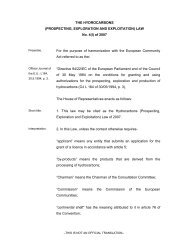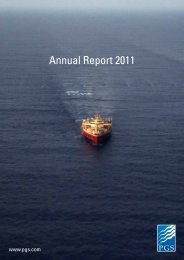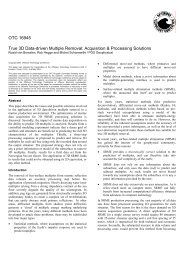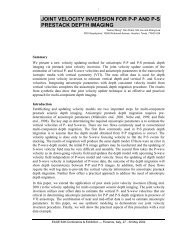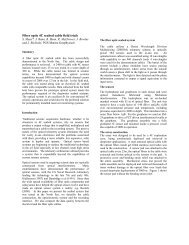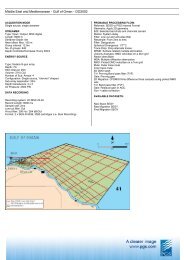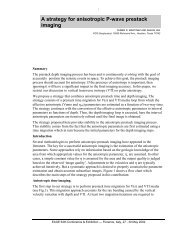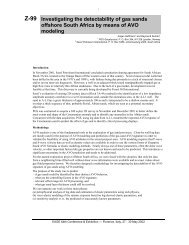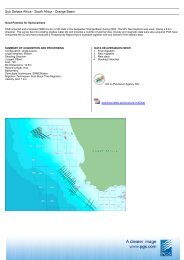Arrow Prospectus - PGS
Arrow Prospectus - PGS
Arrow Prospectus - PGS
Create successful ePaper yourself
Turn your PDF publications into a flip-book with our unique Google optimized e-Paper software.
ARROW SEISMIC ASA – INITIAL PUBLIC OFFERING<br />
8.3.4 Cash and bank deposits<br />
Cash and bank deposits, etc. include bank deposits, cash in hand and short-term bank deposits with an original<br />
maturity of three months or less.<br />
8.3.5 Trade receivables<br />
Trade receivables are initially recognised at fair value and subsequently measured at amortised cost using the<br />
effective interest method, less provision for improvement. A provision for impairment of trade receivables is<br />
established when there is objective evidence that the Group will not be able to collect all amounts due according<br />
to the original terms of receivables. Significant financial difficulties of the debtor, probability that the debtor will<br />
enter bankruptcy or financial reorganisation, and default or delinquency in payments (more than 30 days<br />
overdue) are considered indicators that the trade receivables are impaired. The amount of the provision is the<br />
difference between the asset’s carrying amount and the present value of estimated future cash flows, discounted<br />
at the original effective interest rate. The carrying amount of the asset is reduced through the use of an allowance<br />
account, and the amount of the loss is recognised in the income statement within selling and marketing costs.<br />
When a trade receivable is uncollectible, it is written off against the allowance account for trade receivables.<br />
Subsequent recoveries of amounts previously written off are credited against selling and marketing costs in the<br />
income statement.<br />
8.3.6 Inventories<br />
Inventories are valued at the lower of cost and net realisable value. Cost incurred are accounted for using<br />
purchase cost on a first in, first out basis, and includes costs accrued in acquiring the inventories and bringing the<br />
inventories to its present location and condition. Net realisable value is the estimated selling price in the ordinary<br />
course of business, less estimated costs of completion and the estimated costs necessary to make the sale.<br />
8.3.7 Fixed assets<br />
Fixed assets are decomposed for depreciation purposes. Components that represent a substantial portion of the<br />
vessel’s total cost price are isolated for depreciation purposes, and are depreciated over their expected useful<br />
lives. The useful live is the period that the group expects to use the vessel, and this period can thus be shorter<br />
than the economic life.<br />
If various components have approximately the same useful life and the same depreciation method as other<br />
components, the components are depreciated collectively.<br />
The straight line method for ordinary depreciation based on an economic life of 25 years from when the vessel<br />
was new is used for vessels. With reference to IAS 16, Property, Plant and Equipment, the group uses the cost<br />
price for vessels with a 5 per cent residual value. In special circumstances the group will consider an alternative<br />
depreciation horizon if the circumstances so indicate, such as the purchase and/or upgrading of older vessels.<br />
Improvements and upgrading will be capitalised and depreciated over the remaining life of the vessel. The<br />
straight line method for ordinary depreciation based on a period of 2.5 to 5 years is used for periodic<br />
maintenance. The straight line method for ordinary depreciation based on a life of 3 to 10 years is used for other<br />
depreciable assets.<br />
The depreciation period and method will be assessed annually to ensure that the method and period used are in<br />
accordance with the financial realities of the fixed asset. This applies correspondingly to the scrap value.<br />
Tangible fixed assets are valued at historical cost less any accumulated depreciation and write-downs. When<br />
assets are sold or disposed of, the historical cost and accumulated depreciation are reversed in the accounts and<br />
any loss or gain on the disposal will be recognised in the profit and loss statement.<br />
The write-down of assets will be considered when there is indication of an impairment in value. If the book<br />
value of an asset is higher than the recoverable amount the asset will be written down in the profit and loss<br />
statement. The recoverable amount is the higher of the net sales price and discounted cash flow from continued<br />
use. The net sales price is the amount that can be raised from sale to an independent third party less sales costs.<br />
The recoverable amount is determined separately for all assets, or, if this is not possible, then together with the<br />
unit the asset belongs to.<br />
Write-downs recorded in prior periods will be reversed when there is information indicating that there is no<br />
longer any need for the write-down or the correct write-down amount is no longer the same. The reversal is<br />
recorded as income or an increase in other reserves. However, the reversal will not be performed if the reversal<br />
entails that the recorded value will exceed what the recorded value would have been with normal depreciation<br />
periods.<br />
57



